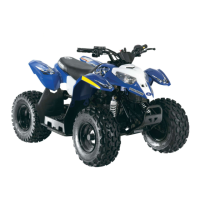What to do if my Polaris Outlaw 9921488 has low battery voltage?
- BBryan LindseyJul 30, 2025
If your Polaris Offroad Vehicle has low battery voltage, recharge the battery using a 0.5 amp charger.

What to do if my Polaris Outlaw 9921488 has low battery voltage?
If your Polaris Offroad Vehicle has low battery voltage, recharge the battery using a 0.5 amp charger.
What to do if there is water present in the fuel of my Polaris Outlaw 9921488 Offroad Vehicle?
If there's water in the fuel of your Polaris Offroad Vehicle, replace the fuel with new fuel.
What to do if my Polaris Outlaw 9921488 Offroad Vehicle has low or contaminated fuel?
If the fuel in your Polaris Offroad Vehicle is low or contaminated, add or change the fuel and clean the fuel system.
What to do if the fuel vent line on my Polaris Outlaw 9921488 Offroad Vehicle is kinked or plugged?
If the fuel vent line on your Polaris Offroad Vehicle is kinked or plugged, inspect and replace it.
| Brand | Polaris |
|---|---|
| Model | Outlaw 9921488 |
| Category | Offroad Vehicle |
| Language | English |
Explains the importance of understanding warnings and safety information.
Details ATV safety training courses and materials provided by Polaris.
Lists essential rules for safe ATV operation, covering attire, riding practices, and environmental considerations.
Introduces the ATV's controls and basic operation for young riders.
Outlines essential checks before riding the ATV to ensure safe operation.
Details safe riding practices, including gear, behavior, and terrain considerations.
Explains the purpose and importance of various safety decals on the ATV.
Covers operational hazards like instruction, age, passengers, terrain, roads, and modifications.
Details warnings on protective gear, alcohol/drug use, speed, and vehicle condition.
Explains main key switch, ignition, start, and stop switches.
Details choke lever, horn, throttle, and brake controls.
Covers fuel system, gas cap, fuel valve, and parking brake operations.
Lists items to check before each ride for safe operation.
Emphasizes the importance of wearing appropriate safety gear for riding.
Covers basic operation, turns, obstacles, slippery surfaces, hills, and water.
Explains noise, crankcase, and exhaust emission control systems.
Provides a schedule for routine maintenance tasks based on hours, calendar, and mileage.
Details recommended lubricants and methods for various ATV components.
Covers engine oil recommendations, checks, and changes.
Details transmission oil and drive chain maintenance procedures.
Explains air filter cleaning and spark plug inspection/replacement.
Covers CVT system care and spark arrestor cleaning.
Discusses carburetor adjustment and speed limiting systems.
Covers throttle cable, brake, toe alignment, and wheel maintenance.
Details battery care, vehicle cleaning, and storage procedures.
Lists key technical specifications for the Outlaw 50 model.
Provides solutions for common engine starting and running problems.
Addresses engine pinging, knocking, backfiring, and irregular operation.
Outlines warranty terms, exclusions, and the registration process.
Guides on service procedures and international warranty coverage.
Covers the specific emissions warranty period and components.